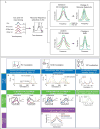Cortical inhibitory interneurons control sensory processing
- PMID: 28938181
- PMCID: PMC5693245
- DOI: 10.1016/j.conb.2017.08.018
Cortical inhibitory interneurons control sensory processing
Abstract
Inhibitory and excitatory neurons form intricate interconnected circuits in the mammalian sensory cortex. Whereas the function of excitatory neurons is largely to integrate and transmit information within and between brain areas, inhibitory neurons are thought to shape the way excitatory neurons integrate information, and they exhibit context-specific and behavior-specific responses. Over the last few years, work across sensory modalities has begun unraveling the function of distinct types of cortical inhibitory neurons in sensory processing, identifying their contribution to controlling stimulus selectivity of excitatory neurons and modulating information processing based on the behavioral state of the subject. Here, we review results from recent studies and discuss the implications for the contribution of inhibition to cortical circuit activity and information processing.
Copyright © 2017 Elsevier Ltd. All rights reserved.
Conflict of interest statement
The authors declare that they have no conflicts of interest with respect to the work described in the manuscript.
Figures


Similar articles
-
Modulation of cortical circuits by top-down processing and arousal state in health and disease.Curr Opin Neurobiol. 2018 Oct;52:172-181. doi: 10.1016/j.conb.2018.06.008. Epub 2018 Jul 29. Curr Opin Neurobiol. 2018. PMID: 30064117 Review.
-
Division and subtraction by distinct cortical inhibitory networks in vivo.Nature. 2012 Aug 16;488(7411):343-8. doi: 10.1038/nature11347. Nature. 2012. PMID: 22878717 Free PMC article.
-
A Neural Circuit That Controls Cortical State, Plasticity, and the Gain of Sensory Responses in Mouse.Cold Spring Harb Symp Quant Biol. 2014;79:1-9. doi: 10.1101/sqb.2014.79.024927. Epub 2015 May 6. Cold Spring Harb Symp Quant Biol. 2014. PMID: 25948638 Free PMC article. Review.
-
Differential Excitation of Distally versus Proximally Targeting Cortical Interneurons by Unitary Thalamocortical Bursts.J Neurosci. 2016 Jun 29;36(26):6906-16. doi: 10.1523/JNEUROSCI.0739-16.2016. J Neurosci. 2016. PMID: 27358449 Free PMC article.
-
Spinal Inhibitory Interneurons: Gatekeepers of Sensorimotor Pathways.Int J Mol Sci. 2021 Mar 6;22(5):2667. doi: 10.3390/ijms22052667. Int J Mol Sci. 2021. PMID: 33800863 Free PMC article. Review.
Cited by
-
Maternal Experience-Dependent Cortical Plasticity in Mice Is Circuit- and Stimulus-Specific and Requires MECP2.J Neurosci. 2020 Feb 12;40(7):1514-1526. doi: 10.1523/JNEUROSCI.1964-19.2019. Epub 2020 Jan 7. J Neurosci. 2020. PMID: 31911459 Free PMC article.
-
Goal-directed action preparation in humans entails a mixture of corticospinal neural computations.bioRxiv [Preprint]. 2025 Feb 7:2024.07.08.602530. doi: 10.1101/2024.07.08.602530. bioRxiv. 2025. Update in: J Physiol. 2025 Mar;603(6):1589-1605. doi: 10.1113/JP287939. PMID: 39026882 Free PMC article. Updated. Preprint.
-
A Guide to Preclinical Models of Zoster-Associated Pain and Postherpetic Neuralgia.Curr Top Microbiol Immunol. 2023;438:189-221. doi: 10.1007/82_2021_240. Curr Top Microbiol Immunol. 2023. PMID: 34524508 Free PMC article. Review.
-
Rethinking Sensory Information Processing: The Essential Role of Astrocytes.J Neurochem. 2025 Jun;169(6):e70113. doi: 10.1111/jnc.70113. J Neurochem. 2025. PMID: 40490971 Free PMC article. Review.
-
Functional diversities within neurons and astrocytes in the adult rat auditory cortex revealed by single-nucleus RNA sequencing.Sci Rep. 2024 Oct 25;14(1):25314. doi: 10.1038/s41598-024-74732-7. Sci Rep. 2024. PMID: 39455606 Free PMC article.
References
-
- Kawaguchi Y. Neostriatal cell subtypes and their functional roles. Neurosci Res. 1997;27:1–8. - PubMed
Publication types
MeSH terms
Grants and funding
LinkOut - more resources
Full Text Sources
Other Literature Sources

